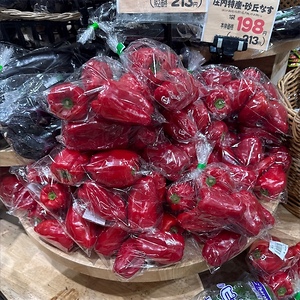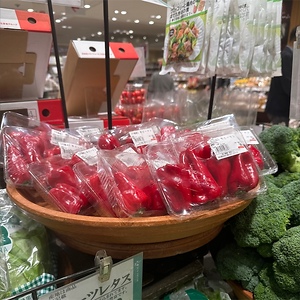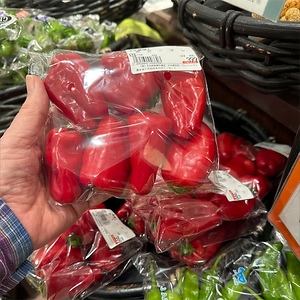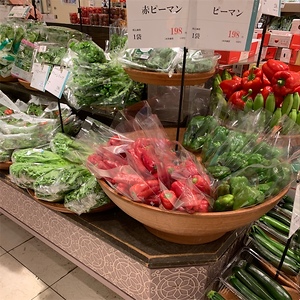


Red Japanese Bellpepper
Estimated Inventory, lb : 0
Description/Taste
Japanese Red bell peppers are small in size, roughly one third the size of the American varieties, and have a rounded, square shape with multiple lobes that narrows and tapers slightly towards the non-stem end. The skin is thin, glossy, smooth, and dark red, and the flesh is bright red, crunchy, juicy, and succulent. There is also a hollow, central cavity filled with pale red to white membranes and many small, flat, and circular cream-colored seeds that may taste slightly bitter if not removed prior to consuming. Japanese Red bell peppers are crisp with a sweet flavor.
Seasons/Availability
Japanese Red bell peppers are available in the spring through fall.
Current Facts
Japanese Red bell peppers, botanically classified as Capsicum annuum, are a small, sweet variety that are members of the Solanaceae family. Also known as Papurika in Japan, Japanese Red bell peppers are harvested once they reach full maturity and are simply the ripe versions of the green bell pepper. The name Papurika is derived from the Dutch word for the pepper known as paprika and is considered a goraigo, which is a version of a foreign word that was assimilated into the Japanese language. Japanese red bell peppers are favored by chefs and home cooks in Japan for their crisp and sweet taste and are commonly fried or grilled for added flavor.
Nutritional Value
Japanese Red bell peppers contain potassium, magnesium, phosphorus, vitamin K, vitamin B6, and vitamin C.
Applications
Japanese Red bell peppers are best suited for both raw and cooked applications such as grilling, baking, sautéing, and frying. When used fresh, the peppers can be chopped into green salads, mixed with vinegar, oils, other vegetables, and cheeses for a flavorful side dish, or sliced and consumed fresh as a snack. The peppers can also be stir-fried with teriyaki sauce, meats, and vegetables, roasted and layered on sandwiches, mixed into pasta, fried with tempura, or pickled and served as a condiment. Japanese Red bell peppers pair well with lotus root, carrots, broccoli, turnips, bamboo shoots, celery, cabbage, eggplant, artichokes, yams, shiso, leeks, mushrooms, onions, garlic, tofu, beef, pork, scallops, oysters, olives, panko, parmesan cheese, soba noodles, rice, soy sauce, and sesame oil. The peppers will keep 4-5 days when stored in the crisper drawer of the refrigerator.
Ethnic/Cultural Info
In Japan, red pepper kinpira is a popular side dish or okazu, which are traditionally made with burdock root or gobo and served with rice. Kinpira is a style of cooking that consists of simmering and sautéing. The word kinpira stems from Sakata no Kinpira, which is a legend of a strong samurai. The belief is that kinpira cooking is a style that makes the consumer feel nourished and strong, just like the samurai in the legend. Some spice may also be added to the side dish as a symbol to represent the heat of battle.
Geography/History
Red bell peppers are native to tropical America and have been growing since ancient times. The seeds of the peppers were then shared with the rest of the world via explorers, and the red bell peppers were introduced to Japan in the early 1990s from exports of peppers from the Netherlands. Today many consumers in Japan believe that the Japanese Red bell pepper is different from the green bell pepper due to the difference in names. Japanese Red bell peppers are predominately found in local markets in Asia and are also found through select retailers in the United States.
Recipe Ideas
Recipes that include Red Japanese Bellpepper. One











